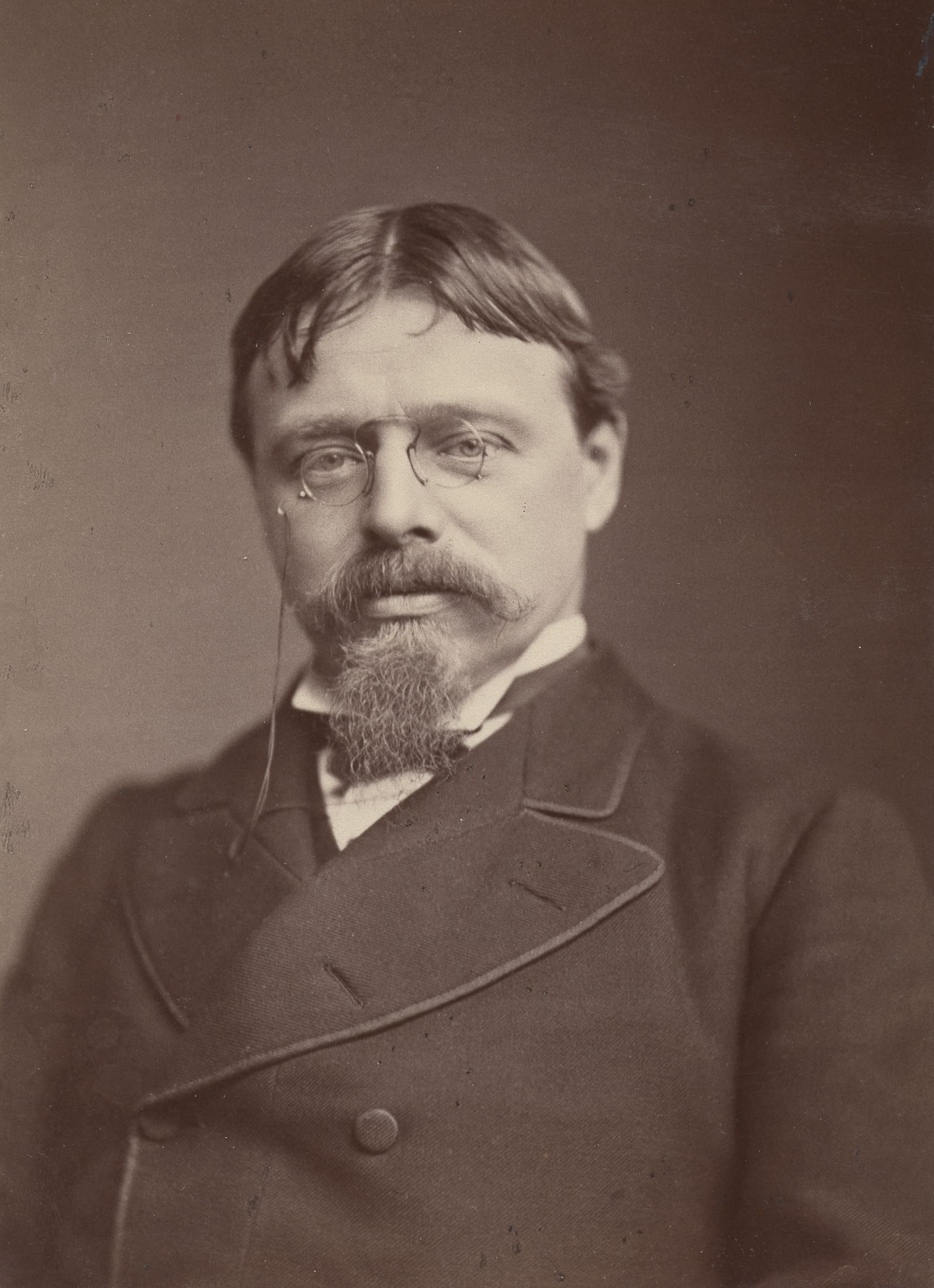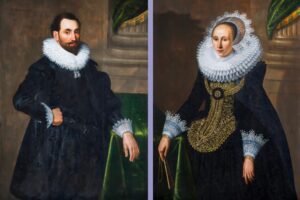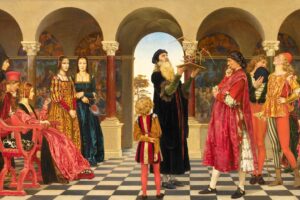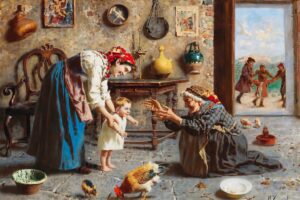Table of Contents
Overview
The Education of the Children of Clovis (1861) by Lawrence Alma-Tadema is a striking early work by the Dutch-born painter who would become one of Victorian Britain’s most celebrated artists. The painting depicts the children of Clovis I, king of the Franks, being taught archery under the stern gaze of their mother, Queen Clotilde.
Rich in historical accuracy and narrative detail, the canvas reveals Alma-Tadema’s fascination with antiquity and his gift for reconstructing the past with archaeological precision. Though created before he fully embraced his Roman themes, it already demonstrates his signature blend of historical drama, emotional intensity, and meticulous realism.
The Story Behind the Painting
Clovis and Clotilde
Clovis I (c. 466–511), the first king to unite the Franks under one rule, and his wife, Queen Clotilde, are central figures in early medieval European history. Clotilde, later canonized as a saint, was known for her Christian devotion and her influence on Clovis’s eventual conversion to Christianity.
The painting imagines a domestic yet symbolic moment: their sons being taught the arts of war. In this education lies both the continuity of royal power and the shaping of future rulers.
Alma-Tadema’s Early Career
Painted in 1861, when Alma-Tadema was just beginning to gain recognition, the work reflects his interest in Merovingian history. At the time, he was still living in Antwerp, studying under Baron Jan August Hendrik Leys, who encouraged historical subjects. This canvas became one of Alma-Tadema’s first successes, demonstrating his mastery of group composition and historical reconstruction.
Historical Drama for a Victorian Audience
Victorian audiences admired such works not only for their historical romance but also for their moral weight. The painting conveys discipline, heritage, and the shaping of character — values that resonated deeply in 19th-century Britain.
Composition and Subjects
The Central Scene
At the heart of the painting, a boy draws back his sling with youthful determination. His golden curls and concentrated expression embody both innocence and emerging strength. Another child, dressed in green, watches intently, holding stones for the sling — a partner in both learning and play.
Queen Clotilde
Seated on a richly decorated throne, Queen Clotilde dominates the background. She is clad in heavy robes, her expression serious, embodying both maternal authority and royal dignity. A younger child clings to her side, a reminder that even in the midst of discipline and training, family bonds remain tender.
Courtiers and Advisors
Surrounding the scene are figures of soldiers, monks, and courtiers. A warrior in chainmail leans on his shield, observing with approval. Clergy in black robes stand nearby, one holding a book, symbolizing moral and spiritual guidance alongside martial training.
Architectural Setting
The action unfolds in a classical-style atrium, framed by marble columns and open to the sky. Though historically anachronistic, Alma-Tadema’s choice reflects his passion for architectural precision and decorative richness, lending grandeur to the domestic lesson.
Subtle Symbolism
On the right, wooden targets marked with circles show the boys’ practice. Their placement emphasizes discipline and continuity, as the children repeat the motions that will one day shape them as leaders.
Art Style and Techniques
Historical Realism
Alma-Tadema approached history with the eye of an archaeologist. Costumes, furnishings, and architecture were rendered with precision, reflecting his deep study of antiquity. Even early in his career, he displayed the obsessive detail that would later define his Roman scenes.
Composition and Drama
The figures are arranged with clarity, guiding the viewer’s eye from the boy’s action to the queen’s solemn presence. The mixture of energy and stillness gives the scene both immediacy and gravitas.
Pre-Raphaelite Influence
Though Alma-Tadema was not formally a Pre-Raphaelite, this painting shows their influence in its jewel-like colors, sharp outlines, and moral storytelling. Like the Brotherhood, he sought to revive history and legend with vibrancy and truth to detail.
Legacy and Reflection
A Defining Early Work
The Education of the Children of Clovis was pivotal in establishing Alma-Tadema’s reputation as a historical painter. It demonstrated his ability to weave narrative, symbolism, and detail into compelling visual drama.
From Merovingians to Romans
After this success, Alma-Tadema increasingly turned toward classical antiquity, eventually becoming famous for his luxuriant Roman recreations. Yet this early canvas shows the seeds of his style — the fascination with domestic life, the architectural precision, and the union of history with human feeling.
Enduring Meaning
The painting continues to resonate as a vision of how power, family, and faith intertwine. The children of Clovis are not just learning to aim a sling — they are being prepared for the weight of history itself.
A boy raises his sling, his brother waits, his mother watches. Around them, soldiers and priests observe in silence. In this moment, Alma-Tadema captures both the innocence of childhood and the gravity of destiny — the shaping of rulers beneath the watchful eyes of history.
About Artist

Sir Lawrence Alma-Tadema OM, RA (January 8, 1836 – June 25, 1912) was a Dutch-born British painter acclaimed for his detailed and lavish depictions of scenes from the ancient world. Born in Dronrijp, Netherlands, Alma-Tadema received his artistic training at the Royal Academy of Antwerp under the Belgian historical painter Hendrik Leys. In 1870, he settled in London, becoming a naturalized British subject in 1873, and rose to prominence for his meticulous and evocative paintings of Roman, Greek, and Egyptian antiquity.
Artist Style and Movement
Alma-Tadema is known for his neoclassical style, characterized by an extraordinary attention to detail, especially in his rendering of marble textures, ancient architecture, and luxurious costumes. His works often present anecdotal scenes of daily life and luxury within ancient civilizations, capturing moments with archaeological accuracy and a vivid sense of realism. He bridged academic painting with historical romanticism, becoming one of the most admired Victorian painters before his style fell out of favor early in the 20th century.
Artwork Profile
- The Education of the Children of Clovis (1861): Alma-Tadema’s breakthrough work, depicting Queen Clotilde instructing her sons in warfare in a detailed, classical courtyard setting.
- The Roses of Heliogabalus (1888): An opulent scene portraying the Roman Emperor Heliogabalus showering guests with rose petals to dangerous excess.
- An Audience at Agrippa’s (1876) and After the Audience: Companion pieces showing a Roman imperial scene with emotional subtlety.
- The Coliseum (1896) and The Baths of Caracalla (1899): Architectural masterpieces illustrating Rome’s grandeur.
- The Finding of Moses (1904): A delicate painting of Pharaoh’s daughter discovering Moses, rich in Egyptian detail.
- Numerous portraits, landscapes, and etchings complement his historic and classical subjects.
Sir Lawrence Alma-Tadema’s rich body of work stands as a testament to Victorian fascination with antiquity, merging scholarly archaeological observation with romantic imagination. His meticulous craftsmanship and vivid storytelling continue to captivate viewers, establishing him as a leading figure in 19th-century classical and historicist painting. Though he experienced a decline in popularity posthumously, a resurgence of interest from the mid-20th century onward has restored his status in art history.



